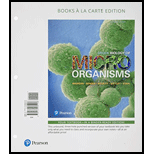
Concept explainers
To explain:
The groups of microbes which are most similar to prokaryotic cell and the related evidences which prove that these microbes are not prokaryotes.
Concept introduction:
All organisms are divided into prokaryotes and eukaryotes. Prokaryotes are characterized by the absence of well defined nucleus which is not enclosed by nuclear membrane. Prokaryotes also lack membrane bound cell organelles. Members of parabasalids belong to Excavata group of protists and are anaerobes in nature. Microsporidia belongs to group of obligate parasitic fungi and infects various types of animals and protists including human beings. Galdieria belongs to group red algae and is commonly found in aquatic environment.
Want to see the full answer?
Check out a sample textbook solution
Chapter 18 Solutions
Brock Biology of Microorganisms, Books a la Carte Plus Mastering Microbiology with Pearson eText -- Access Card Package (15th Edition)
- Pseudopeptidoglycan is a characteristic of the walls of ________. a. eukaryotic cells b. bacterial prokaryotic cells c. archaean prokaryotic cells d. bacterial and archaean prokaryotic cellsarrow_forwardThere are two types of prokaryotes: bacteria and____________________.arrow_forwardWhich statement best describes why antimicrobial drugs that affect cell wall synthesis tend to have selective toxicity when used by humans? Human cells only synthesize peptidoglycan as a food source Cell wall synthesis is a common metabolic process in humans and bacteria. Most bacteria only synthesize cell walls during their log phase of growth. Human cells do not have cell walls.arrow_forward
- Please explain the significance and implications of the "Vernadsky Paradox" from a microbial perspective.arrow_forwardProvide evidence in supporting or refuting the following statement: The cell, or cytoplasmic membrane, is a nonessential structure in bacteria because its function is replaced by the cell wall in these microbes. provide at least 400 of wordsarrow_forwardIn the domain system of classification, prokaryotes are divided into two domains: Bacteria and Archaea. The two domains differ in all BUT one feature. Which feature do they have in common? A. They both thrive in extreme environments. B. They both have prokaryotic cells. C. They both are able to live only under anaerobic conditions. D. They both have identical cell walls.arrow_forward
- The statements are given below, which will best describe why antimicrobial drugs that affect cell wall synthesis tend to have selective toxicity when used by humans? Human cells only synthesize peptidoglycan as a food source Cell wall synthesis is a common metabolic process in humans and bacteria. Most bacteria only synthesize cell walls during their log phase of growth. Human cells do not have cell walls.arrow_forwardWhat microbial structures are the most resilient forms of life? Bacterial endospores Enveloped viruses Fungal spores Gram-positive bacteriaarrow_forwardWhat terms would describe a prokaryote that has is covered in a thick peptidoglycan layer, gets its energy from eating other prokaryotes, and does not need oxygen to survive? Aerobic Anaerobic Autotroph Heterotroph Extremophile Gram-positive Gram-negativearrow_forward
- create your own drawing that provides the types of microorganisms within each category and compares the size of cellular and acellular microorganisms. You must include two microorganisms per category - your submission must demonstrate your understanding of how the sizes and structure of these microorganisms help to classify them as cellular or acellular by adding a brief statement at the bottom of the drawing describing cellular vs acellular please help!arrow_forwardWhat role does the human microfauna play in protecting humans against pathogens? (At this point in the class, you should be able to provide a detailed list of activities bacteria species perform in and on our body that protect us from pathogens.)arrow_forwardWhat terms would describe a prokaryote that is covered thin peptidoglycan layer between two membranes, harnesses energy from the sun, and needs oxygen to survive? Aerobic Anaerobic Autotroph Heterotroph Extremophile Gram-positive Gram-negativarrow_forward
 Comprehensive Medical Assisting: Administrative a...NursingISBN:9781305964792Author:Wilburta Q. Lindh, Carol D. Tamparo, Barbara M. Dahl, Julie Morris, Cindy CorreaPublisher:Cengage Learning
Comprehensive Medical Assisting: Administrative a...NursingISBN:9781305964792Author:Wilburta Q. Lindh, Carol D. Tamparo, Barbara M. Dahl, Julie Morris, Cindy CorreaPublisher:Cengage Learning Microbiology for Surgical Technologists (MindTap ...BiologyISBN:9781111306663Author:Margaret Rodriguez, Paul PricePublisher:Cengage Learning
Microbiology for Surgical Technologists (MindTap ...BiologyISBN:9781111306663Author:Margaret Rodriguez, Paul PricePublisher:Cengage Learning Concepts of BiologyBiologyISBN:9781938168116Author:Samantha Fowler, Rebecca Roush, James WisePublisher:OpenStax College
Concepts of BiologyBiologyISBN:9781938168116Author:Samantha Fowler, Rebecca Roush, James WisePublisher:OpenStax College


